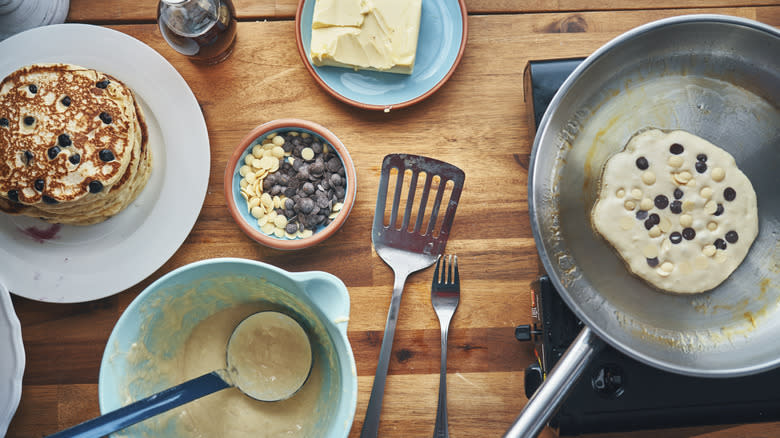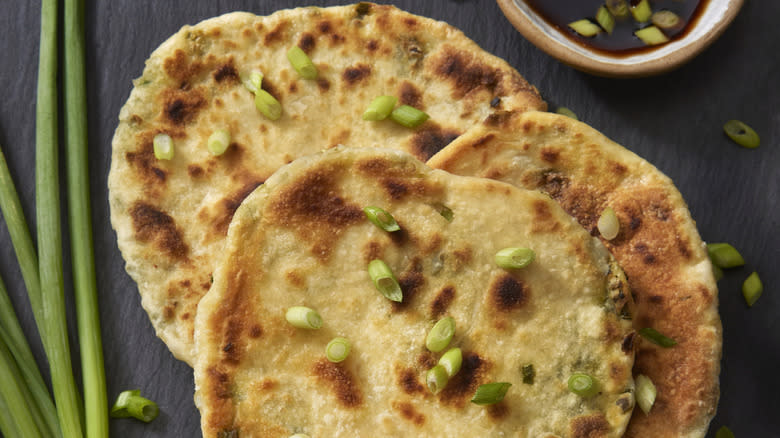S. Ferrari
·4 min read
It may seem as if there's not a single American who wouldn't recognize a stack of pancakes as an icon of the breakfast table, but there's a relative of this morning staple that might be less familiar, though no less delicious. The German pancake, also known as the Dutch baby, is a unique creation with an identity all its own.
While they share a name and a general mealtime (although both would be just as welcome at the dinner table), there are some key differences between these dishes. The stateside style recipe results in a relatively flat confection with an even surface and crisp exterior. The German pancake, on the other hand, is pillowy, like a custardy cloud withcaramelized edges and is usually considerably larger than the more familiar flapjack. A single German pancake is easily shareable, where a serving of American pancakes might arrive as a whole stack.
In terms of ingredients, eggs, milk, flour, sugar, and butter all appear in most versions of both, but the process is what really distinguishes these dishes. A Dutch baby recipe requires that the batter be poured into a skillet and baked. It emerges from the oven almost supernaturally puffy, more like a soufflé or a popover than a pancake as we know it, and eventually deflates, ready to be topped with all manner of delicious accouterments. Classic pancakes in America are typically griddled or skillet fried on the stovetop in butter and usually paired with maple syrup.
ADVERTIsem*nT
Read more: Cake Hacks Every Baker Will Wish They Knew Sooner
Spicing Up Your Pancakes, Regardless Of Style
Whether you opt for the traditional American style or the fluffy Dutch baby, there are a lot of ways to express your pancake personality. The beauty of both is that they work well as a blank slate, allowing you to customize based on seasonality, mood, or simply to utilize what you have hiding in your cupboard.
The German pancake is commonly found with apples baked right in, so that's an obvious place to start, but it's easy to swap in bananas for a foster-like version, pears, peaches, or even mixed berries. Another classic Dutch baby preparation leans into simplicity with just a sprinkle of sugar and squeeze of fresh lemon juice (the batter itself can sometimes call for lemon zest, along with nutmeg or cinnamon), but it is also delicious with a rich and creamy lemon curd. You can also make it savory by adding cheese, sausage, onions and peppers and serving for brunch or dinner.
American diners know that there is no shortage of creative pancake flavors, from menu mainstays like chocolate chip, blueberry, or banana pancakes, to much more elaborate preparations that push the boundaries of what a pancake can be, including the ultimate morning mash-up, cereal pancakes. The possibilities on both fronts are limited only by your imagination and ingredient list.
Other Cultures' Pancake Traditions
Despite their differences, German and American pancakes are both part of a vastglobal cultural category. In fact, many cultures claim some kind of sweetened flat cake in their culinary repertoire, especially since the brief, relatively prevalent list of staple ingredients they share has lent itself well throughout history to adaptability, particularly for peasant classes or in times when resources were scarce.
Spins on international pancakes vary widely. In Indonesia, serabi kuah, the vibrantly green, coconut-inflected flat cakes are made with pandan and palm sugar, and served with anything from kaya jam to caramel and chocolate. In Ethiopia, injera is a sorghum-based pancake made with teff flour and is a staple food integral to the culture and daily life. Latkes, or potato pancakes, are a significant component of Jewish tradition at Hanukkah. Chinese scallion pancakes skew to the savory side with the addition of green onions, while in Italy, a pancake-style dish made from chickpea flour is often served with herbs, as in a rosemary farinata;and in Eastern Europe, buckwheat blinis with caviar can be found gracing tables.
It's even possible to find multiple pancake styles within the same cuisine. For example, the phrase "German pancake" can also refer to another iteration, thepfannkuchen, which is thinner, can be rolled or folded, and more closely resembles a French crêpe than the Dutch baby. In the U.S., meanwhile, hoecakes or johnny cakes are made with corn flour and feature heavily in regional southern American cuisine.
Read the original article on Daily Meal.


